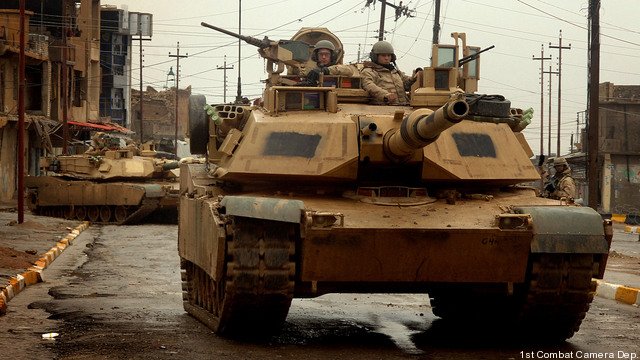Shyu Sings The Army Electric: 2015 Budget Sacrifices Weapons For Electronics
Posted on

UPDATED 2:00 pm Tuesday with detailed 2015 budget figures
WASHINGTON: The 2015 budget effectively kills the Army’s top priority weapons program, the 60-plus-ton Ground Combat Vehicle — as we’ve been predicting since November — but GCV did not die in vain, the Army’s acquisition chief insists.
“We sacrificed the GCV” to save programs upgrading electronics on existing vehicles, assistant secretary Heidi Shyu said last week at a Bloomberg conference. That doesn’t mean Army information technology will escape unscathed when the budget is released tomorrow, or that the service will stop investing in new vehicles.
On the “cut” side of the equation, Shyu has emphasized in a string of recent appearances that the service will take a hit to each of its three largest investment portfolios: aviation, mission command electronics, and ground combat systems, in that order. (The fourth largest, science and technology, is being protected as what Shyu calls “seed corn” for the post-sequestration future).
[UPDATED: With the Army’s 2015 budget request, Science & Technology has vaulted into third place while ground combat systems has dropped out of the top three altogether. Out of a $20.1 billion request for fiscal ’15 modernization programs, the service allocates a whopping 25 percent to aviation, a half-billion-dollar increase from what was enacted in fiscal year 2014, buying 191 helicopters of various types. Aviation’s share is more than double either the 12 percent allocated to “mission command” or the 11 percent for science & technology. Ground combat equipment trails at a mere nine percent.]
The difference is that aviation and ground combat are sacrificing high-profile vehicles — the stillborn Armed Aerial Scout helicopter and the GCV respectively — but mission command will simply buy smaller quantities of networking gear, radios, and so on, rather than kill off an entire major program.
[UPDATED: Overall, the Army is requesting a half-billion more for communications & other electronics than it got last year: $3.29 billion requested for ’15 versus $3.23 billion enacted in ’14. (The original request for 2014, however, was a billion dollars higher, $4.3 billion). Within that portfolio
- the Army’s brigade-wide wifi system, WIN-T (Warfighter Information Network – Tactical), has dropped very slightly, from $789 million to $763 million this year, although a planned future upgrade of WIN-T, the so-called “Increment 3,” has been dialed down to a pure software package without the planned software;
- the chronically troubled Joint Tactical Radio System (JTRS) is slashed in half, to $176 million; and
- wearable networking gear for foot troops, the “Nett Warrior” program, is up significantly, from $62 million enacted in 2014 to $85 billion requested this year — as befits the Army’s increasing focus on the individual soldier.]
On the “keep” side, Shyu has repeatedly mentioned two programs to replace existing and highly vulnerable support vehicles: the Joint Light Tactical Vehicle (JLTV), a new wheeled truck to replace the Humvee, and the Armored Multi-Purpose Vehicle (AMPV), a tracked machine to replace the current range of armored ambulances, mobile command posts, and the like. (See pg. 2 of the RFP for the full list.) Those tracked support vehicles are currently all variants of the Vietnam-vintage M113, which proved so vulnerable in Iraq that commanders eventually stopped letting it drive off base.
While JLTV is well along, with the Army now testing more than 60 vehicles of three competing designs, AMPV is still in the Request For Proposal stage. That doesn’t necessarily make it vulnerable, however. I caught Shyu after her public remarks at the recent Association of the US Army conference and asked if the GCV’s demise made its little brother, AMPV, all the more important to the Army. Her characteristically blunt answer: “Yes.”
[UPDATED: The AMPV budget nearly triples in today’s request, from $28 million in ’14 to $92 million for ’15, as the program moves from a concept to an actual competition among contractors. JLTV has $210 million to complete the current test phase and buy 176 vehicles from whoever the winner ends up being.]
Since both the new JLTV and prospective AMPV are support vehicles, however, the burden of frontline combat will fall on 1980s-vintage machines, principally the M2 Bradley troop carrier — which GCV would have replaced — and the M1 Abrams tank. Since 9/11, both Abrams and Bradleys have been repeatedly upgraded with more armor, more sensors, more computers, and more jammers to defeat roadside bombs. Now they’re “kind of maxed out,” Shyu said at the McAleese conference, with no room, horsepower, or electrical capacity for further upgrades: “We have to buy space, weight, and power back.”
[UPDATED: Upgrades to Abrams, Bradley, and other existing vehicles such as the M109 Paladin howitzer and 8-wheel-drive Stryker total $1.4 billion in the 2015 budget request].
But why not defer such incremental upgrades to existing systems — known as “engineering change proposals” or ECPs — and focus on building something new that’s designed from the ground up for 21st century warfare, like the Ground Combat Vehicle?
The Army still wants something GCV-like, eventually. “If you talk to our warfighter… they feel that from the lessons learned from the last decade of war we need the capability the GCV provides,” Shyu said. “That requirement hasn’t gone away. It’s strictly [a matter of] affordability due to sequestration.”
“Our choice literally was, do we cut the money out of the GCV [or] not fund any of the ECPs on our existing platforms,” Shyu told the McAleese conference. But a new vehicle can’t be fielded overnight at any price, and “there’s nobody guaranteeing me that Army’s not going to fight for the next seven years,” Shyu said. “[I can’t] put a freeze on our existing platforms and just go for the next generation.”
“That was the trade space we were in,” Shyu summed up. “It’s not a pretty place to be.”
Subscribe to our newsletter
Promotions, new products and sales. Directly to your inbox.
